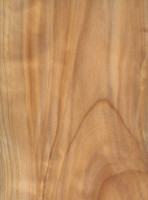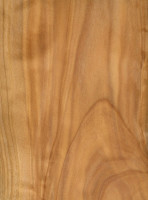 |
Common Name(s): Mediterranean Cypress, Italian Cypress Scientific Name: Cupressus sempervirens Distribution: Eastern Mediterranean region Tree Size: 65-100 ft (20-30 m) tall, 2-3 ft (.6-1 m) trunk diameter Average Dried Weight: 33 lbs/ft3 (535 kg/m3) Specific Gravity (Basic, 12% MC): .44, .54 Janka Hardness: 560 lbf (2,490 N) Modulus of Rupture: 6,460 lbf/in2 (44.6 MPa) Elastic Modulus: 766,000 lbf/in2 (5.28 GPa) Crushing Strength: No data available Shrinkage: No data available |
Color/Appearance: Heartwood is a pale yellowish or reddish brown. Narrow sapwood is paler and usually clearly demarcated from the heartwood.
Grain/Texture: Grain is usually straight, though small knots are sometimes present, creating a more irregular grain pattern. Fine, uniform texture with a good natural luster.
Endgrain: Resin canals absent; earlywood to latewood transition gradual, color contrast low to medium; tracheid diameter small to medium; parenchyma diffuse.
Rot Resistance: Rated as durable; mixed resistance to insect attack.
Workability: Overall easy to work with hand and machine tools, though areas around knots can be problematic. Reportedly difficult to steam bend. Glues, stains, and finishes well.
Odor: Most cypresses in the Cupressus genus have a distinct, fragrant scent.
Allergies/Toxicity: Although severe reactions are quite uncommon, Mediterranean Cypress has been reported to cause skin irritation, rashes, and headaches. See the articles Wood Allergies and Toxicity and Wood Dust Safety for more information.
Pricing/Availability: Not commonly exported for sale, Mediterranean Cypress is oftentimes used locally for utility purposes. Prices are likely to be moderate for an imported softwood.
Sustainability: This wood species is not listed in the CITES Appendices, but is reported by the IUCN as being near threatened. Technically it doesn’t meet the Red List criteria of a vulnerable or endangered species, but is close to qualifying and/or may qualify in the near future.
Common Uses: Utility lumber, fence posts, musical instruments (flamenco guitars), furniture, boatbuilding, and turned objects.
Comments: Mediterranean Cypress is a long-lived tree, with a lifespan over 1,000 years; one specimen in Iran is estimated to be roughly 4,000 years old.
- Alaskan Yellow Cedar (Cupressus nootkatensis)
- Gowen Cypress (Cupressus goveniana)
- Leyland Cypress (Cupressus x leylandii)
- Mexican Cypress (Cupressus lusitanica)
- Monterey Cypress (Cupressus macrocarpa)
None available.
Scans/Pictures: There are currently no pictures of this exact wood species, but a similar species within the Cupressus genus is being substituted (C. macrocarpa). If you’d like to contribute a wood sample of this specific species to be scanned, (even small pieces of veneer can be sent), please use the contact form.






Does anyone know how long italian cypress can last with soil contact in a dry covered environment. i would like to use them as poles in a small pole barn style building.
The heartwood is classified as “Durable” in the Rot Resistance section of the summary (sapwood is generally considered perishable, although I’m not sure whether that applies to this species). Clicking on Rot Resistance takes you to https://www.wood-database.com/wood-articles/wood-durability/ (Wood Durability), where Durable is the second highest classification, with an estimated service life of 15 to 25 years in direct ground contact. Although described as having mixed resistance to insect attack, the essential oil contained in the fragrant wood is repellent to some insects (https://www.ncbi.nlm.nih.gov/pmc/articles/PMC7149725/ ), and it has traditionally been used for chests and wardrobes for linens and food. It has… Read more »
This species is used widely throughout the Mediterranean as a windbreak. It has also recently been shown to be a great firebreak.
https://www.bbc.com/news/science-environment-34116491
Turkish research on natural material grown in southern Turkey found MOR (static bending test) of 76.8 MPa (SD 16.17), for material with average ADD (12%) 621 kg/m3, range 562-684. In other tests ADD (12%) was as high as 746 kg/m3.
I have C. lusitanica sample (branchwood with compression wood from tree growing in my garden in Australia) with ADD 749 kg/m3.
Sounds very strange to me that the MoR of this species is that low as said here, the pieces i do with it are very similar in resistance to cedrus libani O_o’
I would want to donate some spanish samples, there are two variations of sempervirens: stricta and horizontalis.